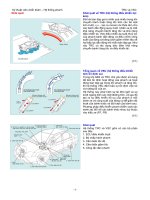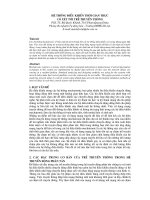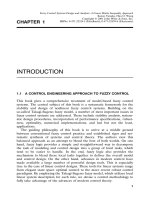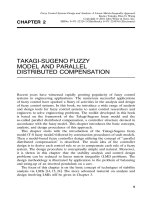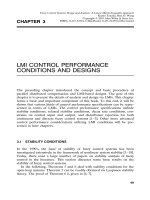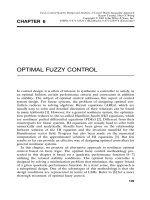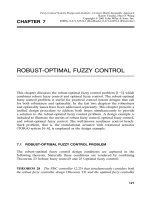Tài liệu Hệ thống điều khiển mờ - Thiết kế và phân tích P2 pptx
Bạn đang xem bản rút gọn của tài liệu. Xem và tải ngay bản đầy đủ của tài liệu tại đây (362.59 KB, 44 trang )
Fuzzy Control Systems Design and Analysis: A Linear Matrix Inequality Approach
Kazuo Tanaka, Hua O. Wang
Copyright ᮊ 2001 John Wiley & Sons, Inc.
Ž. Ž .
ISBNs: 0-471-32324-1 Hardback ; 0-471-22459-6 Electronic
CHAPTER 2
TAKAGI-SUGENO FUZZY
MODEL AND PARALLEL
DISTRIBUTED COMPENSATION
Recent years have witnessed rapidly growing popularity of fuzzy control
systems in engineering applications. The numerous successful applications
of fuzzy control have sparked a flurry of activities in the analysis and design
of fuzzy control systems. In this book, we introduce a wide range of analysis
and design tools for fuzzy control systems to assist control researchers and
engineers to solve engineering problems. The toolkit developed in this book
is based on the framework of the Takagi-Sugeno fuzzy model and the
so-called parallel distributed compensation, a controller structure devised in
accordance with the fuzzy model. This chapter introduces the basic concepts,
analysis, and design procedures of this approach.
This chapter starts with the introduction of the Takagi-Sugeno fuzzy
Ž.
model T-S fuzzy model followed by construction procedures of such models.
Then a model-based fuzzy controller design utilizing the concept of ‘‘parallel
distributed compensation’’ is described. The main idea of the controller
design is to derive each control rule so as to compensate each rule of a fuzzy
system. The design procedure is conceptually simple and natural. Moreover,
it is shown in this chapter that the stability analysis and control design
Ž.
problems can be reduced to linear matrix inequality LMI problems. The
design methodology is illustrated by application to the problem of balancing
and swing-up of an inverted pendulum on a cart.
The focus of this chapter is on the basic concept of techniques of stability
wx
analysis via LMIs 14, 15, 24 . The more advanced material on analysis and
design involving LMIs will be given in Chapter 3.
5
TAKAGI-SUGENO FUZZY MODEL AND PARALLEL DISTRIBUTED COMPENSATION
6
2.1 TAKAGI-SUGENO FUZZY MODEL
The design procedure describing in this book begins with representing a
given nonlinear plant by the so-called Takagi-Sugeno fuzzy model. The fuzzy
wx
model proposed by Takagi and Sugeno 7 is described by fuzzy IF-THEN
rules which represent local linear input-output relations of a nonlinear
system. The main feature of a Takagi-Sugeno fuzzy model is to express the
Ž.
local dynamics of each fuzzy implication rule by a linear system model.
The overall fuzzy model of the system is achieved by fuzzy ‘‘blending’’ of the
linear system models. In this book, the readers will find that many nonlinear
dynamic systems can be represented by Takagi-Sugeno fuzzy models. In fact,
it is proved that Takagi-Sugeno fuzzy models are universal approximators.
The details will be discussed in Chapter 14.
The ith rules of the T-S fuzzy models are of the following forms, where
CFS and DFS denote the continuous fuzzy system and the discrete fuzzy
system, respectively.
Continuous Fuzzy System: CFS
Model Rule i:
Ž. Ž.
IF ztis M and иии and ztis M ,
1 i1 pip
x t s Ax t q Bu t ,
Ž. Ž. Ž.
˙
ii
THEN i s 1,2,...,r.2.1
Ž.
½
y t s Cx t ,
Ž. Ž.
i
Discrete Fuzzy System: DFS
Model Rule i:
Ž. Ž.
IF ztis M and иии and ztis M ,
1 i1 pip
x t q 1 s Ax t q Bu t ,
Ž . Ž. Ž.
ii
THEN i s 1, 2, . . . , r.2.2
Ž.
½
y t s Cx t ,
Ž. Ž.
i
Ž.
n
Here, M is the fuzzy set and r is the number of model rules; x t g R is
ij
Ž.
m
Ž.
q
the state vector, u t g R is the input vector, y t g R is the output
n=nn=mq=n
Ž. Ž.
vector, A g R , B g R , and C g R ; zt,..., ztare known
ii i1 p
premise variables that may be functions of the state variables, external
Ž.
disturbances, andror time. We will use z t to denote the vector containing
Ž. Ž.
all the individual elements zt,..., zt. It is assumed in this book that the
1 p
Ž.
premise variables are not functions of the input variables u t . This assump-
tion is needed to avoid a complicated defuzzification process of fuzzy
wx
controllers 12 . Note that stability conditions derived in this book can be
TAKAGI-SUGENO FUZZY MODEL
7
applied even to the case that the premise variables are functions of the input
Ž. Ž.
variables u t . Each linear consequent equation represented by Axt q
i
Ž.
But is called a ‘‘subsystem.’’
i
ŽŽ. Ž..
Given a pair of x t , u t , the final outputs of the fuzzy systems are
inferred as follows:
CFS
r
w z t Ax t q Bu t
Ä4
Ž. Ž. Ž.
Ž.
Ý
iii
i
s1
x t s
Ž.
˙
r
w z t
Ž.
Ž.
Ý
i
i
s1
r
s h z t Ax t q Bu t ,2.3
Ä4
Ž. Ž. Ž. Ž .
Ž.
Ý
iii
i
s1
r
w z t Cx t
Ž. Ž.
Ž.
Ý
ii
i
s1
y t s
Ž.
r
w z t
Ž.
Ž.
Ý
i
i
s1
r
s h z t Cx t .2.4
Ž. Ž. Ž .
Ž.
Ý
ii
i
s1
DFS
r
w z t Ax t q Bu t
Ä4
Ž. Ž. Ž.
Ž.
Ý
iii
i
s1
x t q 1 s
Ž.
r
w z t
Ž.
Ž.
Ý
i
i
s1
r
s h z t Ax t q Bu t ,2.5
Ä4
Ž. Ž. Ž. Ž .
Ž.
Ý
iii
i
s1
r
w z t Cx t
Ž. Ž.
Ž.
Ý
ii
i
s1
y t s
Ž.
r
w z t
Ž.
Ž.
Ý
i
i
s1
r
s h z t Cx t ,2.6
Ž. Ž. Ž .
Ž.
Ý
ii
i
s1
TAKAGI-SUGENO FUZZY MODEL AND PARALLEL DISTRIBUTED COMPENSATION
8
where
z t s ztztиии zt,
Ž. Ž. Ž. Ž.
12 p
p
w z t s Mzt,
Ž. Ž.
Ž.
Ž.
Ł
iijj
j
s1
w z t
Ž.
Ž.
i
h z t s 2.7
Ž. Ž .
Ž.
r
i
w z t
Ž.
Ž.
Ý
i
i
s1
ŽŽ.. Ž.
for all t. The term Mzt is the grade of membership of zt in M .
ij j j ij
Since
r
°
w z t ) 0,
Ž.
Ž.
Ý
i
~
2.8
Ž.
i
s1
¢
w z t G 0, i s 1,2,...,r ,
Ž.
Ž.
i
we have
r
°
h z t s 1,
Ž.
Ž.
Ý
i
~
2.9
Ž.
i
s1
¢
h z t G 0, i s 1,2,...,r ,
Ž.
Ž.
i
for all t.
Example 1 Assume in the DFS that
p s n,
zts xt, zts xty 1 ,..., zts xty n q 1.
Ž. Ž. Ž. Ž . Ž. Ž .
12 n
Then, the model rules can be represented as follows.
Model Rule i:
Ž. Ž .
IF xt is M and иии and xty n q 1isM ,
i1 in
x t q 1 s Ax t q Bu t ,
Ž . Ž. Ž.
ii
THEN i s 1,2,...,r,
½
y t s Cx t ,
Ž. Ž.
i
Ž. w Ž. Ž . Ž .x
T
where x t s xt xty 1 иии xty n q 1.
Remark 1 The Takagi-Sugeno fuzzy model is sometimes referred as the
Ž.
Takagi-Sugeno-Kang fuzzy model TSK fuzzy model in the literature. In this
Ž. Ž.
book, the authors do not refer to 2.1 and 2.2 as the TSK fuzzy model. The
CONSTRUCTION OF FUZZY MODEL
9
reason is that this type of fuzzy model was originally proposed by Takagi and
wx w x
Sugeno in 7 . Following that, Kang and Sugeno 8, 9 did excellent work on
identification of the fuzzy model. From this historical background, we feel
Ž. Ž.
that 2.1 and 2.2 should be addressed as the Takagi-Sugeno fuzzy model.
On the other hand, the excellent work on identification by Kang and Sugeno
is best referred to as the Kang-Sugeno fuzzy modeling method. In this book
the authors choose to distinguish between the Takagi-Sugeno fuzzy model
and the Kang-Sugeno fuzzy modeling method.
2.2 CONSTRUCTION OF FUZZY MODEL
Figure 2.1 illustrates the model-based fuzzy control design approach dis-
cussed in this book. To design a fuzzy controller, we need a Takagi-Sugeno
fuzzy model for a nonlinear system. Therefore the construction of a fuzzy
model represents an important and basic procedure in this approach. In this
section we discuss the issue of how to construct such a fuzzy model.
In general there are two approaches for constructing fuzzy models:
Ž.
1. Identification fuzzy modeling using input-output data and
2. Derivation from given nonlinear system equations.
There has been an extensive literature on fuzzy modeling using input-out-
wx
put data following Takagi’s, Sugeno’s, and Kang’s excellent work 8, 9 . The
procedure mainly consists of two parts: structure identification and parame-
ter identification. The identification approach to fuzzy modeling is suitable
Fig. 2.1 Model-based fuzzy control design.
TAKAGI-SUGENO FUZZY MODEL AND PARALLEL DISTRIBUTED COMPENSATION
10
for plants that are unable or too difficult to be represented by analytical
andror physical models. On the other hand, nonlinear dynamic models for
mechanical systems can be readily obtained by, for example, the Lagrange
method and the Newton-Euler method. In such cases, the second approach,
which derives a fuzzy model from given nonlinear dynamical models, is more
appropriate. This section focuses on this second approach. This approach
utilizes the idea of ‘‘sector nonlinearity,’’ ‘‘local approximation,’’ or a combi-
nation of them to construct fuzzy models.
2.2.1 Sector Nonlinearity
The idea of using sector nonlinearity in fuzzy model construction first
wx
appeared in 10 . Sector nonlinearity is based on the following idea. Consider
Ž. Ž Ž.. Ž.
a simple nonlinear system xt s fxt , where f 0 s 0. The aim is to find
˙
Ž. Ž Ž.. wxŽ.
the global sector such that xt s fxt g aaxt. Figure 2.2 illustrates
˙
12
the sector nonlinearity approach. This approach guarantees an exact fuzzy
model construction. However, it is sometimes difficult to find global sectors
for general nonlinear systems. In this case, we can consider local sector
nonlinearity. This is reasonable as variables of physical systems are always
bounded. Figure 2.3 shows the local sector nonlinearity, where two lines
Ž.
become the local sectors under yd - xt - d. The fuzzy model exactly
Ž.
represents the nonlinear system in the ‘‘local’’ region, that is, yd - xt - d.
The following two examples illustrate the concrete steps to construct fuzzy
models.
Fig. 2.2 Global sector nonlinearity.
CONSTRUCTION OF FUZZY MODEL
11
Fig. 2.3 Local sector nonlinearity.
Example 2 Consider the following nonlinear system:
xt yxtq xtx
3
t
Ž. Ž. Ž. Ž.
˙
1112
s . 2.10
Ž.
3
ž/ž /
xt yxtq 3 q xt xt
Ž. Ž. Ž. Ž.
Ž.
˙
22 21
Ž. wx Ž. wx
For simplicity, we assume that xtgy1, 1 and xtgy1, 1 . Of
12
Ž. Ž.
course, we can assume any range for xt and xtto construct a fuzzy
12
model.
Ž.
Equation 2.10 can be written as
2
y1 xtx t
Ž. Ž.
12
x t s x t ,
Ž. Ž.
˙
2
3 q xt xt y1
Ž. Ž.
Ž.
21
Ž. w Ž. Ž.x
T
Ž.
2
Ž. Ž Ž..
2
Ž.
where x t s xtxt and xtx tand 3 q xtxt are nonlinear
12 12 2 1
Ž. Ž.
2
Ž. Ž. Ž
terms. For the nonlinear terms, define zt' xtx t and zt' 3 q
112 2
Ž..
2
Ž.
xtxt. Then, we have
21
y1 zt
Ž.
1
x t s x t .
Ž. Ž.
˙
zt y1
Ž.
2
TAKAGI-SUGENO FUZZY MODEL AND PARALLEL DISTRIBUTED COMPENSATION
12
Ž. Ž.
Next, calculate the minimum and maximum values of ztand ztunder
12
Ž. wx Ž. wx
xtgy1, 1 and xtgy1, 1 . They are obtained as follows:
12
max zts 1, min ztsy1,
Ž. Ž.
11
Ž. Ž. Ž. Ž.
xt, xt xt, xt
12 12
max zts 4, min zts 0.
Ž. Ž.
22
Ž. Ž. Ž. Ž.
xt, xt xt, xt
12 12
Ž. Ž.
From the maximum and minimum values, ztand ztcan be represented
12
by
zts xtx
2
t s Mzt и 1 q Mzt и y1,
Ž. Ž. Ž. Ž. Ž. Ž .
Ž. Ž.
112 11 21
zts 3 q xt x
2
t s Nz t и 4 q Nzt и 0,
Ž. Ž. Ž. Ž. Ž.
Ž. Ž.Ž.
2211222
where
Mzt q Mzt s 1,
Ž. Ž.
Ž. Ž.
11 21
Nzt q Nzt s 1.
Ž. Ž.
Ž. Ž.
12 2 2
Therefore the membership functions can be calculated as
ztq 11y zt
Ž. Ž.
11
Mzt s , Mzt s ,
Ž. Ž.
Ž. Ž.
11 21
22
zt 4 y zt
Ž. Ž.
22
Nzt s , Nzt s .
Ž. Ž.
Ž. Ž.
12 22
44
We name the membership functions ‘‘Positive,’’ ‘‘Negative,’’ ‘‘Big,’’ and
Ž.
‘‘Small,’’ respectively. Then, the nonlinear system 2.10 is represented by the
following fuzzy model.
Model Rule 1:
Ž. Ž.
IF ztis ‘‘Positive’’ and ztis ‘‘Big,’’
12
Ž. Ž.
THEN x t s Axt.
˙
1
Model Rule 2:
Ž. Ž.
IF ztis ‘‘Positive’’ and ztis ‘‘Small,’’
12
Ž. Ž.
THEN x t s Axt .
˙
2
Model Rule 3:
Ž. Ž.
IF ztis ‘‘Negative’’ and ztis ‘‘Big,’’
12
CONSTRUCTION OF FUZZY MODEL
13
Ž Ž .. Ž Ž ..
Fig. 2.4 Membership functions Mzt and Mzt.
11 21
ŽŽ.. ŽŽ..
Fig. 2.5 Membership functions Nzt and Nzt.
12 22
Ž. Ž.
THEN x t s Axt .
˙
3
Model Rule 4:
Ž. Ž.
IF ztis ‘‘Negative’’ and ztis ‘‘Small,’’
12
Ž. Ž.
THEN x t s Axt .
˙
4
Here,
y11 y11
A s , A s ,
12
4 y10y1
y1 y1 y1 y1
A s , A s .
34
4 y10y1
Figures 2.4 and 2.5 show the membership functions.
The defuzzification is carried out as
4
x t s h z t Ax t ,
Ž. Ž. Ž.
Ž.
˙
Ý
ii
i
s1
TAKAGI-SUGENO FUZZY MODEL AND PARALLEL DISTRIBUTED COMPENSATION
14
where
h z t s Mzt = Nz t ,
Ž. Ž. Ž.
Ž.
Ž. Ž.
11112
h z t s Mzt = Nzt ,
Ž. Ž. Ž.
Ž.
Ž. Ž.
21122
h z t s Mzt = Nz t ,
Ž. Ž. Ž.
Ž.
Ž. Ž.
32112
h z t s Mzt = Nzt.
Ž. Ž. Ž.
Ž.
Ž. Ž.
42122
This fuzzy model exactly represents the nonlinear system in the region
wxwx
y1, 1 = y1, 1 on the x -x space.
12
wx
Example 3 The equations of motion for the inverted pendulum 21 are
xts xt,
Ž. Ž.
˙
12
g sin xt y amlx
2
t sin 2 xtr2 y a cos xt ut
Ž. Ž. Ž. Ž. Ž.
Ž. Ž . Ž.
121 1
xts ,
Ž.
˙
2
2
4lr3 y aml cos xt
Ž.
Ž.
1
2.11
Ž.
Ž. Ž .
where xtdenotes the angle in radians of the pendulum from the vertical
1
Ž.
2
and xt is the angular velocity; g s 9.8 mrs is the gravity constant,
2
m is the mass of the pendulum, M is the mass of the cart, 2 l is the length
Ž.
of the pendulum, and u is the force applied to the cart in newtons ;
Ž.
a s 1r m q M .
Ž.
Equation 2.11 is rewritten as
1
xts
Ž.
˙
2
2
4lr3 y aml cos xt
Ž.
Ž.
1
=
amlx t sin 2 xt
Ž. Ž.
Ž.
21
g sin xt y xty a cos xt ut .
Ž. Ž. Ž. Ž.
Ž. Ž.
121
ž/
2
2.12
Ž.
Define
1
zt' ,
Ž.
1
2
4lr3 y aml cos xt
Ž.
Ž.
1
zt' sin xt ,
Ž. Ž.
Ž.
21
zt' xtsin 2 xt ,
Ž. Ž. Ž.
Ž.
32 1
zt' cos xt ,
Ž. Ž.
Ž.
41
Ž. Ž . Ž. wx
where xtgy
r2,
r2 and xtgy
␣
,
␣
. Note that the system is
12
Ž.
uncontrollable when xts "
r2. To maintain controllability of the fuzzy
1
CONSTRUCTION OF FUZZY MODEL
15
Ž. wx Ž.
model, we assume that xtgy88Њ,88Њ . Equation 2.12 is rewritten as
1
aml
xts z t gz t y ztxty az t u t .
Ž. Ž. Ž. Ž. Ž. Ž. Ž.
˙
212 32 4
½5
2
Ž. Ž.
As shown in Example 2, we replace zty zt with T-S fuzzy model
14
representation. Since
1
max zts ' q ,

s cos 88Њ ,
Ž. Ž .
11
2
4lr3 y aml

Ž.
xt
1
1
min zts ' q ,
Ž.
12
4lr3 y aml
Ž.
xt
1
Ž.
ztcan be rewritten as
1
2
zts Ezt q, 2.13
Ž. Ž. Ž .
Ž.
Ý
1 i 1 i
i
s1
where
zty qqy zt
Ž. Ž.
12 11
Ezt s , Ezt s .
Ž. Ž.
Ž. Ž.
11 21
q y qqy q
12 12
ŽŽ.. ŽŽ..
The membership functions, Ezt and Ezt, are obtained from the
11 2 1
ŽŽ.. ŽŽ..
property of Ezt q Ezts 1.
11 21
Ž. Ž Ž.. Ž.
Figure 2.6 shows zts sin xt and its local sector, where xtg
21 1
Ž. wx
y
r2,
r2 . From Figure 2.6, we can find the sector b , b that consists of
21
two lines bx and bx, where the slopes are b s 1 and b s 2r
.
11 2 1 1 2
ŽŽ..
Fig. 2.6 sin xt and its sector.
1
TAKAGI-SUGENO FUZZY MODEL AND PARALLEL DISTRIBUTED COMPENSATION
16
ŽŽ..
Therefore, we represent sin xt as follows:
1
2
zts sin xt s Mz t b xt. 2.14
Ž. Ž. Ž. Ž. Ž .
Ž. Ž.
Ý
21 i 2 i 1
ž/
i
s1
w ŽŽ.. ŽŽ.. x
From the property of membership functions Mzt q Mzts 1,we
12 2 2
can obtain the membership functions
°
y1
zty 2r
Sin zt
Ž. Ž . Ž.
Ž.
22
, zt/ 0,
Ž.
2
~
y1
Mzt s
Ž.
Ž.
1 y 2r
Sin zt
Ž. Ž.
Ž.
12
2
¢
1, otherwise,
°
y1
Sin zt y zt
Ž. Ž.
Ž.
22
, zt/ 0
Ž.
2
~
y1
Mzt s
Ž.
Ž.
1 y 2r
Sin zt
Ž.Ž.
Ž.
22
2
¢
0, otherwise.
Ž. Ž. Ž Ž..
Next, consider zts xtsin 2 xt. Since
32 1
max zts
␣
' c and min ztsy
␣
' c ,
Ž. Ž.
31 3 2
Ž. Ž. Ž. Ž.
xt, xt xt, xt
12 12
Ž.
we can derive in the same way as the ztcase:
1
2
zts xtsin 2 xt s N z tc, 2.15
Ž. Ž. Ž. Ž. Ž .
Ž.
Ž.
Ý
32 1 ii
i
s1
where
zty ccy zt
Ž. Ž.
32 13
Nzt s , Nzt s .
Ž. Ž.
Ž. Ž.
13 23
c y ccy c
12 12
Ž.
We take the same procedure for ztas well. Since
4
max zts 1 ' d and min zts

' d ,
Ž. Ž.
41 4 2
Ž. Ž.
xt xt
11
we obtain
2
zts cos xt s S z td, 2.16
Ž. Ž. Ž. Ž .
Ž.
Ž.
Ý
41 ii
i
s1
where
zty ddy zt
Ž. Ž.
42 14
Szt s , Szt s .
Ž. Ž.
Ž. Ž.
14 24
d y ddy d
12 12
CONSTRUCTION OF FUZZY MODEL
17
Ž.Ž.
From 2.13 ᎐ 2.16 , we construct the following Takagi-Sugeno fuzzy model
for the inverted pendulum:
22 22
xt
Ž.
˙
1
s Ezt Mz t N z t Sz t
Ž. Ž. Ž. Ž.
Ž.Ž.Ž.Ž.
ÝÝÝÝ
i 1 j 2 k 3 l 4
xt
Ž.
˙
2
i
s1 js1 ks1 ls1
=
01
0
xt
Ž.
1
aml
q ut
Ž.
g и qb y qc
ya и qd
xt
Ž.
ij ik
0
il
2
2
22 22
s Ezt Mz t N z t Sz t
Ž. Ž. Ž. Ž.
Ž.Ž.Ž.Ž.
ÝÝÝÝ
i 1 j 2 k 3 l 4
i
s1 js1 ks1 ls1
= Axt q B ut . 2.17
Ž. Ž. Ž .
Ä4
ijkl ijkl
Ž.
The summations in 2.17 can be aggregated as one summation:
16
x t s h z t A*x t q B*ut , 2.18
Ž. Ž. Ž. Ž. Ž .
Ž.
Ä4
˙
Ý
s1
where
s l q 2 k y 1 q 4 j y 1 q 8 i y 1,
Ž.Ž.Ž.
h z t s Ezt Mz t N z t Szt ,
Ž. Ž. Ž. Ž. Ž.
Ž.
Ž.Ž.Ž.Ž.
i 1 j 2 k 3 l 4
A* s A , B* s B .
ijkl
ijkl
Ž.
Equation 2.18 means that the fuzzy model has the following 16 rules:
Model Rule 1:
Ž. Ž.
IF ztis ‘‘Positive’’ and ztis ‘‘Zero’’
12
Ž. Ž.
and ztis ‘‘Positive’’ and ztis ‘‘Big,’’
34
Ž. Ž. Ž.
THEN x t s A*x t q B*ut.
˙
11
Model Rule 2:
Ž. Ž.
IF ztis ‘‘Positive’’ and ztis ‘‘Zero’’
12
Ž. Ž.
and ztis ‘‘Positive’’ and ztis ‘‘Small,’’
34
Ž. Ž. Ž.
THEN x t s A*x t q B*ut.
˙
22
Model Rule 3:
Ž. Ž.
IF ztis ‘‘Positive’’ and ztis ‘‘Zero’’
12
Ž. Ž.
and ztis ‘‘Negative’’ and ztis ‘‘Big,’’
34
Ž. Ž. Ž.
THEN x t s A*x t q B*ut.
˙
33
TAKAGI-SUGENO FUZZY MODEL AND PARALLEL DISTRIBUTED COMPENSATION
18
Model Rule 4:
Ž. Ž.
IF ztis ‘‘Positive’’ and ztis ‘‘Zero’’
12
Ž. Ž.
and ztis ‘‘Negative’’ and ztis ‘‘Small,’’
34
Ž. Ž. Ž.
THEN x t s A*x t q B*ut.
˙
44
Model Rule 5:
Ž. Ž.
IF ztis ‘‘Positive’’ and ztis ‘‘Not Zero’’
12
Ž. Ž.
and ztis ‘‘Positive’’ and ztis ‘‘Big,’’
34
Ž. Ž. Ž.
THEN x t s A*x t q B*ut.
˙
55
Model Rule 6:
Ž. Ž.
IF ztis ‘‘Positive’’ and ztis ‘‘Not Zero’’
12
Ž. Ž.
and ztis ‘‘Positive’’ and ztis ‘‘Small,’’
34
Ž. Ž. Ž.
THEN x t s A*x t q B*ut.
˙
66
Model Rule 7:
Ž. Ž.
IF ztis ‘‘Positive’’ and ztis ‘‘Not Zero’’
12
Ž. Ž.
and ztis ‘‘Negative’’ and ztis ‘‘Big,’’
34
Ž. Ž. Ž.
THEN x t s A*x t q B*ut.
˙
77
Model Rule 8:
Ž. Ž.
IF ztis ‘‘Positive’’ and ztis ‘‘Not Zero’’
12
Ž. Ž.
and ztis ‘‘Negative’’ and ztis ‘‘Small,’’
34
Ž. Ž. Ž.
THEN x t s A*x t q B*ut.
˙
88
Model Rule 9:
Ž. Ž.
IF ztis ‘‘Negative’’ and ztis ‘‘Zero’’
12
Ž. Ž.
and ztis ‘‘Positive’’ and ztis ‘‘Big,’’
34
Ž. Ž. Ž.
THEN x t s A*x t q B*ut.
˙
99
CONSTRUCTION OF FUZZY MODEL
19
Model Rule 10:
Ž. Ž.
IF ztis ‘‘Negative’’ and ztis ‘‘Zero’’
12
Ž. Ž.
and ztis ‘‘Positive’’ and ztis ‘‘Small,’’
34
Ž. Ž. Ž.
THEN x t s A *x t q B *ut.
˙
10 10
Model Rule 11:
Ž. Ž.
IF ztis ‘‘Negative’’ and ztis ‘‘Zero’’
12
Ž. Ž.
and ztis ‘‘Negative’’ and ztis ‘‘Big,’’
34
Ž. Ž. Ž.
THEN x t s A *x t q B *ut.
˙
11 11
Model Rule 12:
Ž. Ž.
IF ztis ‘‘Negative’’ and ztis ‘‘Zero’’
12
Ž. Ž.
and ztis ‘‘Negative’’ and ztis ‘‘Small,’’
34
Ž. Ž. Ž.
THEN x t s A *x t q B *ut.
˙
12 12
Model Rule 13:
Ž. Ž.
IF ztis ‘‘Negative’’ and ztis ‘‘Not Zero’’
12
Ž. Ž.
and ztis ‘‘Positive’’ and ztis ‘‘Big,’’
34
Ž. Ž. Ž.
THEN x t s A *x t q B *ut.
˙
13 13
Model Rule 14:
Ž. Ž.
IF ztis ‘‘Negative’’ and ztis ‘‘Not Zero’’
12
Ž. Ž.
and ztis ‘‘Positive’’ and ztis ‘‘Small,’’
34
Ž. Ž. Ž.
THEN x t s A *x t q B *ut.
˙
14 14
Model Rule 15:
Ž. Ž.
IF ztis ‘‘Negative’’ and ztis ‘‘Not Zero’’
12
Ž. Ž.
and ztis ‘‘Negative’’ and ztis ‘‘Big,’’
34
Ž. Ž. Ž.
THEN x t s A *x t q B *ut.
˙
15 15
TAKAGI-SUGENO FUZZY MODEL AND PARALLEL DISTRIBUTED COMPENSATION
20
Model Rule 16:
Ž. Ž.
IF ztis ‘‘Negative’’ and ztis ‘‘Not Zero’’
12
Ž. Ž.
and ztis ‘‘Negative’’ and ztis ‘‘Small,’’
34
Ž. Ž. Ž.
THEN x t s A *x t q B *ut.
˙
16 16
Ž. Ž. Ž. Ž.
Here, zt, zt, ztand ztare premise variables and
12 3 4
01 0
UU
aml
A s A s , B s B s ,
1 1111 1 1111
g и qb y и qc ya и qd
11 11 11
2
01 0
UU
aml
A s A s , B s B s ,
2 1112 2 1112
g и qb y и qc ya и qd
11 11 12
2
01 0
UU
aml
A s A s , B s B s ,
3 1121 3 1121
g и qb y и qc ya и qd
11 12 11
2
01 0
UU
aml
A s A s , B s B s ,
4 1122 4 1122
g и qb y и qc ya и qd
11 12 12
2
01 0
UU
aml
A s A s , B s B s ,
5 1211 5 1211
g и qb y и qc ya и qd
12 11 11
2
01 0
UU
aml
A s A s , B s B s ,
6 1212 6 1212
g и qb y и qc ya и qd
12 11 12
2
01 0
UU
aml
A s A s , B s B s ,
7 1221 7 1221
g и qb y и qc ya и qd
12 12 11
2
01 0
UU
aml
A s A s , B s B s ,
8 1222 8 1222
g и qb y и qc ya и qd
12 12 12
2
01 0
UU
aml
A s A s , B s B s ,
9 2111 9 2111
g и qb y и qc ya и qd
21 21 21
2
CONSTRUCTION OF FUZZY MODEL
21
01 0
UU
aml
A s A s , B s B s ,
10 2112 10 2112
g и qb y и qc ya и qd
21 21 22
2
01 0
UU
aml
A s A s , B s B s ,
11 2121 11 2121
g и qb y и qc ya и qd
21 22 21
2
01 0
UU
aml
A s A s , B s B s ,
12 2122 12 2122
g и qb y и qc ya и qd
21 22 22
2
01 0
UU
aml
A s A s , B s B s ,
13 2211 13 2211
g и qb y и qc ya и qd
22 21 21
2
01 0
UU
aml
A s A s , B s B s ,
14 2212 14 2212
g и qb y и qc ya и qd
22 21 22
2
01 0
UU
aml
A s A s , B s B s ,
15 2221 15 2221
g и qb y и qc ya и qd
22 22 21
2
01 0
UU
aml
A s A s , B s B s .
16 2222 16 2222
g и qb y и qc ya и qd
22 22 22
2
Figures 2.7᎐2.10 show the membership functions, that is,
zty qqy zt
Ž. Ž.
12 11
Ezt s , Ezt s ,
Ž. Ž.
Ž. Ž.
11 21
q y qqy q
12 12
sin xt y 2r
zt xty zt
Ž. Ž . Ž. Ž. Ž.
Ž.
12 12
Mzt s , Mzt s ,
Ž. Ž.
Ž. Ž.
12 22
1 y 2r
zt 1 y 2r
zt
Ž . Ž. Ž . Ž.
22
zty ccy zt
Ž. Ž.
32 13
Nzt s , Nzt s ,
Ž. Ž.
Ž. Ž.
13 2 3
c y ccy c
12 12
zty ddy zt
Ž. Ž.
42 14
Szt s , Szt s .
Ž. Ž.
Ž. Ž.
14 2 4
d y ddy d
12 12
